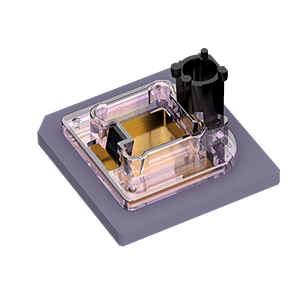
If you have ever clicked around the PacBio website or attended a workshop or webinar discussing PacBio long-read sequencing technology, then you have probably seen or heard about SMRT (Single Molecule, Real-Time) Cells. These small but vital pieces of technology sit at the heart of HiFi (high fidelity) sequencing, one of the world’s most advanced long-read genome sequencing technologies. But what is a SMRT Cell exactly, and what can it do? Let’s take a look!
What is a SMRT Cell?
A SMRT Cell is a small consumable device that is roughly the size and shape of a computer chip where the chemistry of HiFi sequencing takes place on PacBio long-read sequencing instruments.

Prior to sequencing, SMRT Cells are loaded into the PacBio long-read sequencing instrument much like you would load an ink cartridge into a printer. The flat interior surface of the SMRT Cell contains numerous nanometer-scale perforations or wells called zero mode waveguides (ZMWs). Once sample DNA molecules diffuse down inside the ZMWs, sequencing begins, and the DNA is imaged in real-time using powerful, state-of-the-art optics.
Why are SMRT Cells designated “8M” or “25M”?
The “M” number designation indicates how many millions of ZMWs there are within that SMRT Cell. A SMRT Cell 8M contains 8 million ZMWs; the Revio “25M” SMRT Cell contains 25 million ZMWs, and so on. The more densely packed ZMWs are within the SMRT Cell, the more molecules that can be sequenced at once which speeds up sequencing time and drives down the cost of analyzing samples. However, the quantity of ZMWs in a SMRT Cell does not necessarily indicate the exact number of reads that can be obtained from it in a sequencing run. For example, during whole genome sequencing (WGS) the number of HiFi reads generated per SMRT Cell is sometimes less than the number of ZMWs available. At the same time, the number of reads generated using molecular concatenation kits (e.g., MAS-Seq) can be more than triple the number of ZMWs (e.g., 80 million reads from one Revio “25M” SMRT Cell). The throughput metrics presented for PacBio long-read instruments consider this data output range.
How much sequencing can I do with one Revio SMRT Cell?

Currently, the most powerful SMRT Cell in the PacBio lineup is the Revio SMRT Cell which is used exclusively on the new high-throughput Revio system. With 25 million ZMWs in the Revio SMRT Cell, you can generate game-changing long-read data for a variety of applications using just one of these powerful little pieces of technology.
The capabilities of just one Revio SMRT Cell include:
- Up to 90 Gb of total long-read sequencing data in 24 hours.†
- One phased 30x human whole genome.†
- Up to 80 million full-length RNA isoforms using the MAS-Seq single-cell kit.†
- Large, targeted gene panels (e.g., Dark Gene) for up to 12 samples.†
- Small, targeted gene panels (e.g., Long-read PGx) for up to 72 samples.†
- Approximately 170 high quality metagenome assembled genomes (HQ-MAGs) from a human gut microbiome sample.†*
These are just some examples of the kinds of studies that can be performed with a single Revio SMRT Cell. Bear in mind that a fully loaded Revio system can accept 8 of these new SMRT Cells at a time and can analyze up to 4 at once –so the sequencing possibilities are tremendous!
What is needed to prepare SMRT Cells for sequencing?
Nothing at all! SMRT Cells come ready to use. Simply load the SMRT Cells onto your PacBio long-read instrument following the appropriate protocols (along with pipette tips and sample plates) and you are ready to begin sequencing!
Want to learn more about PacBio long-read sequencing?
Check out this primer on long reads
Watch how HiFi sequencing works
Explore Revio, our most powerful long-read sequencer